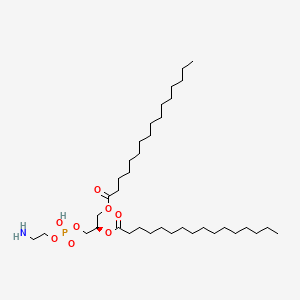| MeSH term | MeSH ID | Detail |
|---|---|---|
| Hemolysis | D006461 | 131 associated lipids |
| Adenocarcinoma | D000230 | 166 associated lipids |
| Lung Neoplasms | D008175 | 171 associated lipids |
| Pancreatic Neoplasms | D010190 | 77 associated lipids |
| Diabetic Retinopathy | D003930 | 39 associated lipids |
| Edema | D004487 | 152 associated lipids |
| Prostatic Neoplasms | D011471 | 126 associated lipids |
| Carcinoma, Small Cell | D018288 | 21 associated lipids |
| Metabolism, Inborn Errors | D008661 | 46 associated lipids |
| Eye Diseases | D005128 | 12 associated lipids |
923-61-5
923-61-5 is a lipid of Glycerophospholipids (GP) class. 923-61-5 is associated with abnormalities such as Gigantism, Hyperostosis of skull, BOSLEY-SALIH-ALORAINY SYNDROME, Anemia, Sickle Cell and Amyloidosis. The involved functions are known as Protein Binding, Anabolism, Signal Transduction, Detergents and Genetic Translation Process. 923-61-5 often locates in soluble, Tissue membrane, brush border membrane, Mouse Kidney and Plasma membrane. The associated genes with 923-61-5 are THEMIS gene, SLC33A1 gene, P4HTM gene, Integral Membrane Proteins and Protein Structure. The related lipids are 1,2-oleoylphosphatidylcholine, Unilamellar Vesicles, Membrane Lipids, DOPE and Micelles.
Cross Reference
Introduction
To understand associated biological information of 923-61-5, we collected biological information of abnormalities, associated pathways, cellular/molecular locations, biological functions, related genes/proteins, lipids and common seen animal/experimental models with organized paragraphs from literatures.
What diseases are associated with 923-61-5?
923-61-5 is suspected in Gigantism, BOSLEY-SALIH-ALORAINY SYNDROME, Anemia, Sickle Cell, Amyloidosis, Cholera, Hyperostosis of skull and other diseases in descending order of the highest number of associated sentences.
Related references are mostly published in these journals:
| Disease | Cross reference | Weighted score | Related literature |
|---|
Possible diseases from mapped MeSH terms on references
We collected disease MeSH terms mapped to the references associated with 923-61-5
PubChem Associated disorders and diseases
What pathways are associated with 923-61-5
There are no associated biomedical information in the current reference collection.
PubChem Biomolecular Interactions and Pathways
Link to PubChem Biomolecular Interactions and PathwaysWhat cellular locations are associated with 923-61-5?
Visualization in cellular structure
Associated locations are in red color. Not associated locations are in black.
Related references are published most in these journals:
| Location | Cross reference | Weighted score | Related literatures |
|---|
What functions are associated with 923-61-5?
Related references are published most in these journals:
| Function | Cross reference | Weighted score | Related literatures |
|---|
What lipids are associated with 923-61-5?
Related references are published most in these journals:
| Lipid concept | Cross reference | Weighted score | Related literatures |
|---|
What genes are associated with 923-61-5?
Related references are published most in these journals:
| Gene | Cross reference | Weighted score | Related literatures |
|---|
What common seen animal models are associated with 923-61-5?
There are no associated biomedical information in the current reference collection.
NCBI Entrez Crosslinks
All references with 923-61-5
Download all related citations| Authors | Title | Published | Journal | PubMed Link |
|---|---|---|---|---|
| Kato C et al. | Oligomannose-coated liposomes activate ERK via Src kinases and PI3K/Akt in J774A.1 cells. | 2008 | Biochem. Biophys. Res. Commun. | pmid:18538131 |
| Brandes LJ and Bogdanovic RP | New evidence that the antiestrogen binding site may be a novel growth-promoting histamine receptor (?H3) which mediates the antiestrogenic and antiproliferative effects of tamoxifen. | 1986 | Biochem. Biophys. Res. Commun. | pmid:3947341 |
| Kroeger EA and Brandes LJ | Evidence that tamoxifen is a histamine antagonist. | 1985 | Biochem. Biophys. Res. Commun. | pmid:4052074 |
| Kichler A et al. | Efficient gene delivery with neutral complexes of lipospermine and thiol-reactive phospholipids. | 1995 | Biochem. Biophys. Res. Commun. | pmid:7733911 |
| Okada N et al. | Binding of C3 molecules to membranes via the SH-residue generated by the cleavage of a thioester bond can initiate complement activation. | 1988 | Biochem. Biophys. Res. Commun. | pmid:3348808 |
| Saxena SP et al. | Histamine formed in stimulated human platelets is cytoplasmic. | 1989 | Biochem. Biophys. Res. Commun. | pmid:2803292 |
| Warrington RC | L-histidinol in experimental cancer chemotherapy: improving the selectivity and efficacy of anticancer drugs, eliminating metastatic disease and reversing the multidrug-resistant phenotype. | 1992 | Biochem. Cell Biol. | pmid:1353969 |
| Stoll MS et al. | Improved procedure for the construction of neoglycolipids having antigenic and lectin-binding activities, from reducing oligosaccharides. | 1988 | Biochem. J. | pmid:3223939 |
| Rüstow B et al. | Studies on the formation of dipalmitoyl species of phosphatidylcholine and phosphatidylethanolamine in pulmonary type II cells. | 1992 | Biochem. J. | pmid:1546960 |
| Brandes LJ et al. | Histamine as an intracellular messenger. | 1990 | Biochem. Pharmacol. | pmid:2242003 |
